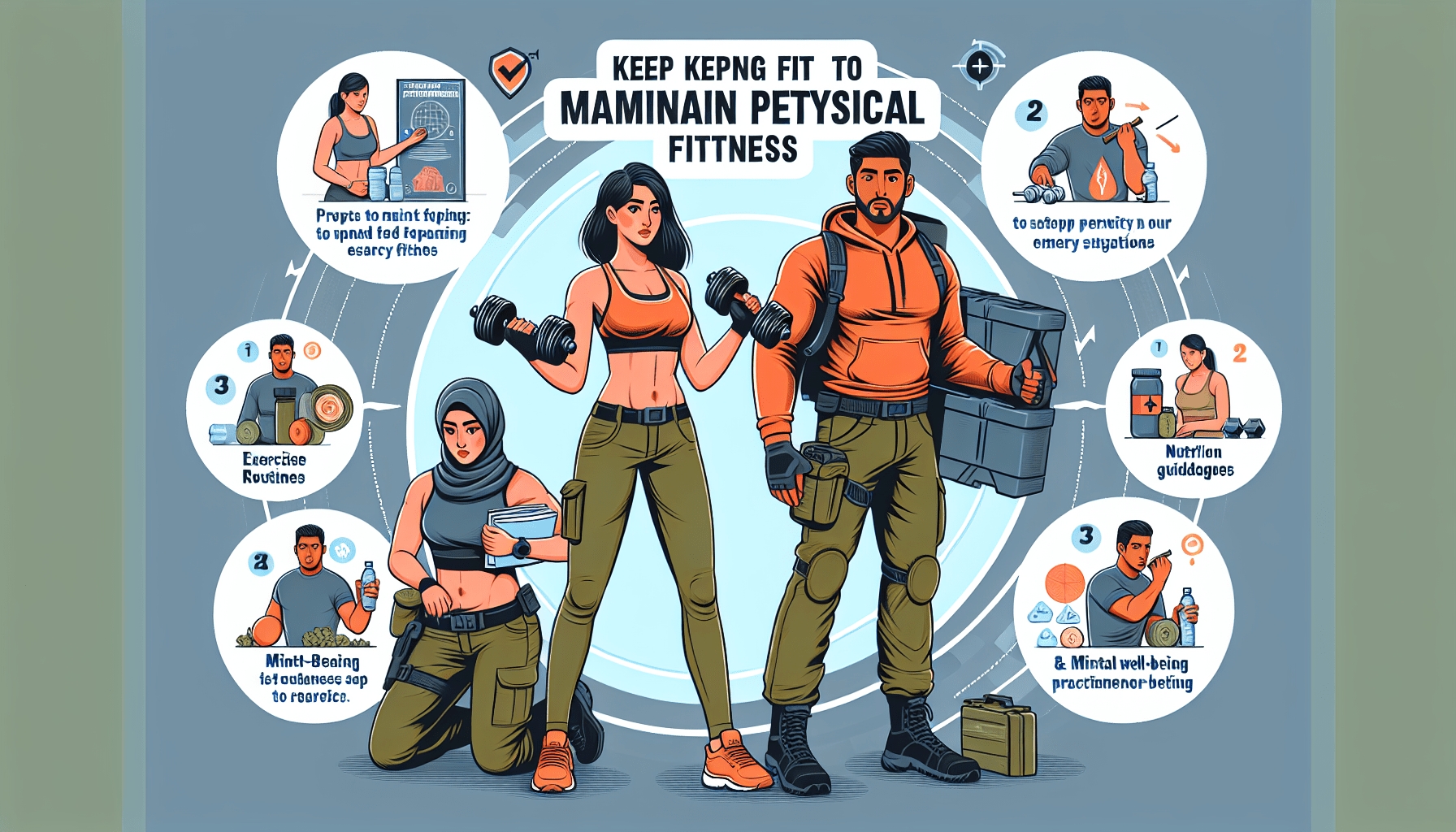Staying physically fit is crucial for preppers. In this article, you will discover the top ways to maintain your physical fitness as a prepper. From incorporating regular exercise routines and outdoor activities to emphasizing the importance of nutrition, these tips will help you stay in top shape, ensuring you are prepared for any survival situation that may come your way. So, let’s dive in and explore the best strategies to keep yourself physically fit as a prepper.
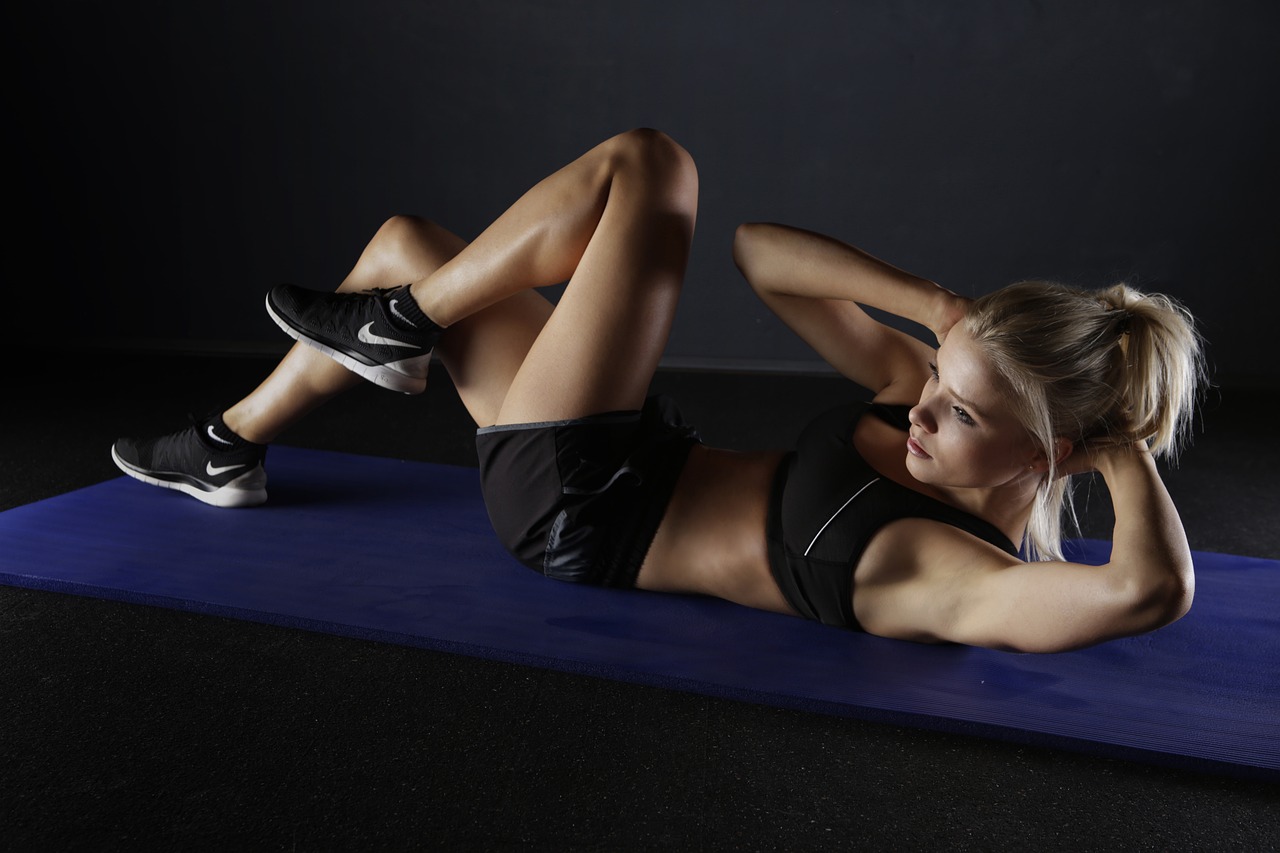
Cardiovascular Exercise
Running
Running is a fantastic cardiovascular exercise that can be easily incorporated into your fitness routine. Whether you prefer to hit the pavement or the treadmill, running helps to improve your cardiovascular fitness, build endurance, and burn calories. Start with a comfortable pace and gradually increase your intensity and distance as your fitness level improves. Running can be done solo or with a running buddy, making it a versatile exercise that can be enjoyed in any setting.
Cycling
Cycling is a low-impact aerobic exercise that provides a great workout for your cardiovascular system. Whether you prefer to bike outdoors or use a stationary bike, cycling helps to strengthen your leg muscles, improve your stamina, and increase your lung capacity. It’s a fun and enjoyable way to explore the outdoors, commute to work, or even participate in competitive cycling events. Get yourself a reliable bike and start pedaling your way to better cardiovascular fitness.
Swimming
Swimming is a full-body workout that engages your muscles, improves your cardiovascular health, and enhances your flexibility. It’s a low-impact exercise that puts minimal stress on your joints, making it suitable for people of all ages and fitness levels. Swimming not only helps to burn calories and improve your endurance but also provides a refreshing and relaxing experience. Whether you swim laps, take a water aerobics class, or simply enjoy leisurely swims, incorporating swimming into your fitness routine can have numerous benefits.
Jumping rope
Jumping rope may seem like a childhood activity, but it’s actually a highly effective cardiovascular exercise that offers a multitude of benefits. It helps to improve your coordination, agility, and cardiovascular endurance. Jumping rope also engages multiple muscle groups, including your legs, core, and shoulders, making it a great full-body workout. It’s a versatile exercise that can be done virtually anywhere, making it perfect for those who are short on time or prefer to workout at home. Grab a jump rope and start jumping your way to better cardiovascular fitness.
High-intensity interval training (HIIT)
HIIT is a popular and efficient way to improve your cardiovascular fitness, burn calories, and build endurance. It involves short bursts of intense exercise followed by short recovery periods. This type of training not only helps to increase your heart rate and improve your cardiovascular health but also promotes fat burning and boosts your metabolism. HIIT workouts can be done with various exercises, such as sprinting, burpees, or kettlebell swings, and can be modified to suit your fitness level. Incorporating HIIT into your fitness routine can help you achieve maximum results in minimal time.
Strength Training
Bodyweight exercises (push-ups, squats, lunges)
Bodyweight exercises are a convenient and effective way to build strength and improve muscle tone without the need for any equipment. Push-ups, squats, and lunges are just a few examples of bodyweight exercises that target multiple muscle groups. They help to strengthen your upper body, lower body, and core, improving your overall stability and balance. Bodyweight exercises can be easily modified to suit your fitness level, making them suitable for beginners and advanced individuals alike. Incorporating these exercises into your fitness routine can help you develop functional strength and improve your overall physique.
Weightlifting
Weightlifting, also known as resistance training, involves using external weights or machines to challenge your muscles and build strength. It’s a highly effective way to increase muscle mass, improve bone density, and boost your metabolism. Weightlifting exercises can target specific muscle groups, such as bicep curls for your arms or squats for your lower body. It’s important to start with lighter weights and gradually increase the resistance as you become stronger. Including weightlifting in your fitness routine can help you achieve a lean and toned physique while reaping numerous health benefits.
Resistance band exercises
Resistance bands are a versatile and portable tool that can be used to add resistance to various exercises. They come in different levels of resistance, allowing you to adjust the intensity based on your fitness level. Resistance band exercises help to strengthen and tone your muscles, improve your flexibility, and enhance your overall functional fitness. They can be used to target specific muscle groups or incorporated into full-body workouts. Whether you’re at home, in the gym, or traveling, resistance band exercises offer a convenient and effective way to incorporate strength training into your routine.
Calisthenics
Calisthenics is a form of bodyweight training that combines strength, flexibility, and cardiovascular fitness. It involves using your bodyweight to perform exercises such as pull-ups, dips, and planks. Calisthenics exercises help to improve your muscle strength, endurance, and mobility. They can be done anywhere, without the need for any equipment, making them a practical choice for those who prefer to exercise outdoors or don’t have access to a gym. Incorporating calisthenics into your fitness routine can help you develop functional strength and improve your overall athleticism.
Yoga or Pilates
Yoga and Pilates are both mind-body exercises that focus on strength, flexibility, and balance. They help to improve your posture, enhance your core strength, and reduce stress. Yoga involves holding poses and flowing sequences, while Pilates focuses on controlled movements and engaging your core muscles. Both practices offer numerous benefits, including improved flexibility, increased muscle tone, and enhanced mental well-being. Whether you prefer the meditative aspects of yoga or the precise movements of Pilates, incorporating these practices into your fitness routine can help you achieve a balanced and harmonious approach to fitness.
Endurance Training
Long-distance running
Long-distance running, also known as endurance running, involves covering long distances typically exceeding 5 kilometers. It’s a challenging yet rewarding form of exercise that helps to improve your cardiovascular endurance, mental toughness, and overall fitness. Training for long-distance running requires gradually increasing your mileage and incorporating speed workouts and recovery days. It’s important to listen to your body and avoid overtraining to prevent injury. Whether you’re training for a marathon or simply enjoy the freedom of going for long runs, endurance training can help you push your limits and achieve new levels of fitness.
Hiking
Hiking is a fantastic way to improve your cardiovascular fitness while enjoying the beauty of nature. Whether you’re hiking on flat terrain or challenging mountain trails, it provides a great cardiovascular workout, builds lower body strength, and improves your balance and coordination. Hiking can be done at your own pace, making it suitable for people of all fitness levels. It’s a great way to escape the hustle and bustle of daily life, reduce stress, and connect with the outdoors. Grab a backpack, lace-up your hiking boots, and embark on a hiking adventure to enhance your endurance and embrace the wonders of nature.
Cycling long distances
Cycling long distances is not only a great way to explore new areas but also an effective endurance training exercise. Whether you’re on a road bike or a mountain bike, cycling long distances helps to improve your cardiovascular fitness, build leg strength, and enhance your overall endurance. It’s important to gradually increase your mileage and incorporate different terrains and intensities into your rides to challenge yourself. Cycling is a low-impact exercise that puts minimal stress on your joints, making it suitable for people of all ages and fitness levels. So hop on your bike and start pedaling towards better endurance and exhilarating adventures.
Rowing
Rowing is a full-body workout that engages multiple muscle groups and provides a great cardiovascular challenge. Whether you’re rowing on a machine at the gym, taking a rowing class, or actually rowing on water, it helps to improve your cardiovascular fitness, build upper body strength, and increase your overall endurance. Rowing is a low-impact exercise that puts minimal stress on your joints, making it suitable for people recovering from injuries or with joint pain. It’s a great way to vary your workouts and add excitement to your fitness routine. So grab an oar or hop on a rowing machine and start rowing your way to improved endurance and a stronger physique.
Cross-country skiing
Cross-country skiing is a winter sport that provides a fantastic endurance workout while enjoying the beauty of snowy landscapes. It engages your upper and lower body muscles, improves your cardiovascular fitness, and enhances your balance and coordination. Cross-country skiing can be done on groomed trails or off-trail, offering various levels of intensity and challenge. It’s a low-impact exercise that puts minimal stress on your joints, making it suitable for people of all fitness levels. Whether you’re a beginner or an experienced skier, cross-country skiing is a great way to stay active during winter and improve your endurance.
Flexibility and Mobility Exercises
Stretching exercises
Stretching exercises help to improve your flexibility, increase your range of motion, and prevent muscle imbalances and injuries. Static stretching, where you hold a stretch for a specific period, and dynamic stretching, where you perform controlled movements, are both beneficial for improving flexibility. Incorporating stretching exercises into your fitness routine can help you enhance your athletic performance, relieve muscle tension, and improve your overall mobility.
Yoga
Yoga is a practice that combines breath control, meditation, and physical postures to improve flexibility, strength, and mental well-being. It involves various poses that target specific muscle groups while incorporating deep stretches. Regular yoga practice can help you develop better body awareness, improve your posture, and reduce stress and anxiety. Whether you prefer gentle yoga or more intense forms like power yoga, incorporating yoga into your fitness routine can help you achieve a balanced mind-body connection and improve your flexibility.
Pilates
Pilates is a low-impact exercise method that focuses on strengthening your core muscles, improving your posture, and enhancing your overall flexibility and mobility. It involves precise movements that engage your deep abdominal muscles and promote proper alignment. Pilates exercises can be performed on a mat or using specialized equipment such as the reformer or the Pilates chair. Regular Pilates practice can help you develop a strong and stable core, increase your body awareness, and improve your overall functional fitness.
Foam rolling
Foam rolling, also known as self-myofascial release, is a self-massage technique that helps to release muscle tension, improve circulation, and enhance your overall mobility and flexibility. It involves using a foam roller to apply pressure to specific areas of your body, targeting tight muscles and trigger points. Foam rolling can help alleviate muscle soreness, increase your range of motion, and improve your overall recovery. It’s a simple and effective way to incorporate self-care and promote better flexibility and mobility in your fitness routine.
Tai chi
Tai chi is an ancient Chinese martial art that focuses on slow, controlled movements, deep breathing, and meditation. It promotes relaxation, balance, and overall wellness. Tai chi exercises are gentle on the joints and can be performed by people of all ages and fitness levels. Regular practice of tai chi can help improve your posture, increase your flexibility, and reduce stress and anxiety. Whether you’re looking for a low-impact exercise or a mindful practice, incorporating tai chi into your fitness routine can help you achieve better flexibility and mobility while promoting inner peace and harmony.
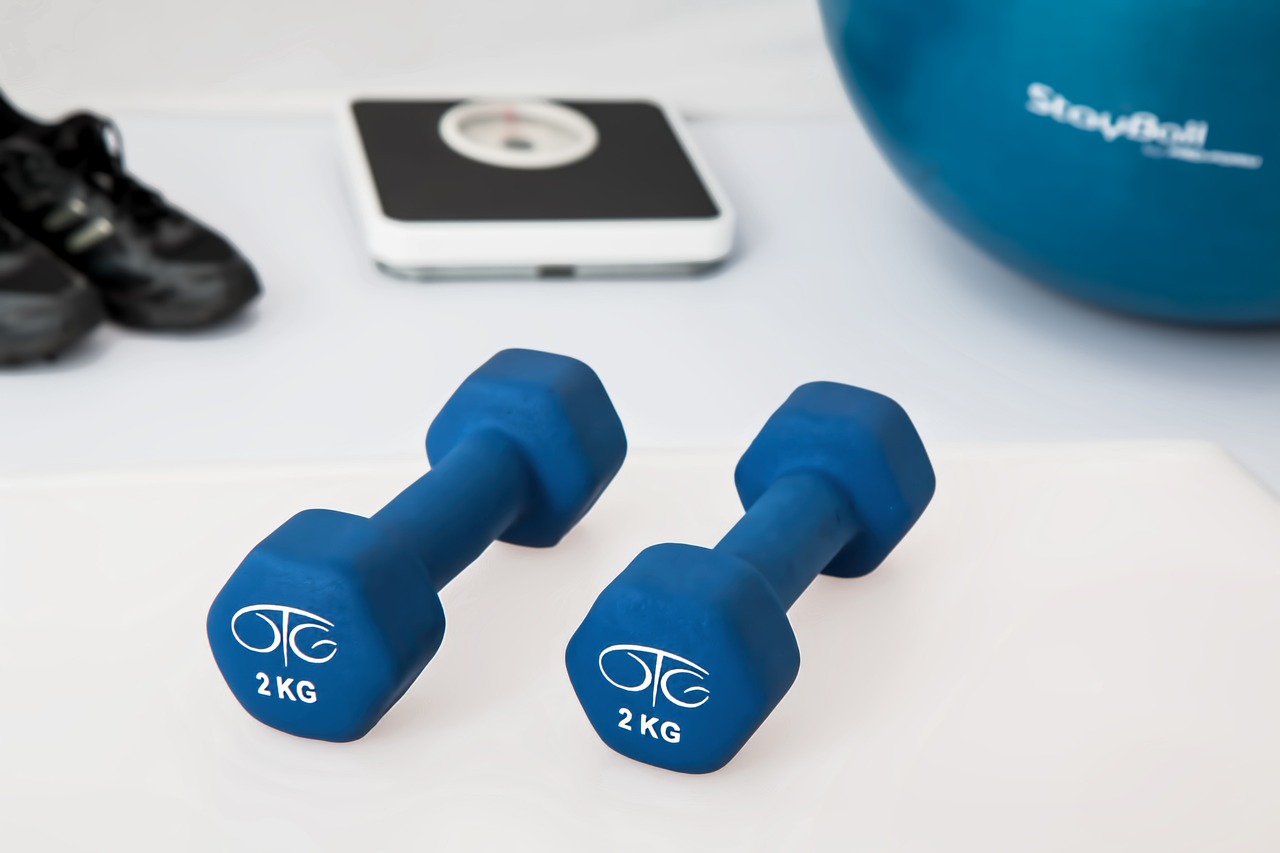
Functional Fitness
Bodyweight exercises
Bodyweight exercises are not only great for building strength but also for improving your functional fitness. They mimic everyday movements and help you become better at performing daily activities, such as lifting, pushing, and pulling. Bodyweight exercises, such as push-ups, squats, and planks, engage multiple muscle groups and require a good level of stability and coordination. Incorporating bodyweight exercises into your fitness routine can help you develop strength, improve your balance, and enhance your overall functionality in daily life.
Kettlebell workouts
Kettlebell workouts are a dynamic and efficient way to improve your functional fitness. Kettlebells are weighted balls with handles that can be swung, lifted, and pressed in various movements. They engage multiple muscle groups and promote cardiovascular fitness, strength, and power. Kettlebell exercises, such as kettlebell swings, Turkish get-ups, and snatches, challenge your muscles and improve your coordination and stability. Whether you’re a beginner or an advanced exerciser, incorporating kettlebell workouts into your fitness routine can help you develop functional strength and improve your overall athleticism.
Functional movement training
Functional movement training focuses on improving your ability to perform everyday movements with efficiency and reduced risk of injury. It involves exercises that mimic natural movements, such as bending, twisting, and reaching. Functional movement training can include exercises with equipment like stability balls, BOSU balls, or resistance bands, as well as bodyweight exercises. It helps to improve your balance, stability, and overall body control. Incorporating functional movement training into your fitness routine can help you become more physically capable and confident in your daily activities.
Agility drills
Agility drills involve quick, coordinated movements that challenge your speed, reaction time, and coordination. They help to improve your agility, balance, and overall athleticism. Agility drills can include ladder drills, cone drills, or lateral movements. Incorporating agility drills into your fitness routine can help you become more responsive and agile in both sports and everyday life.
Obstacle course training
Obstacle course training involves navigating through a series of physical challenges, such as climbing walls, crawling under obstacles, and carrying heavy objects. It provides a full-body workout that improves your strength, endurance, and problem-solving skills. Obstacle course training can be done at specialized courses or by creating your own course using available equipment. Whether you’re training for a specific obstacle course event or simply want to challenge yourself, incorporating obstacle course training into your fitness routine can help you develop functional fitness and prepare for any physical challenge that comes your way.
Outdoor Activities
Hiking
Hiking allows you to experience the beauty of nature while providing an excellent workout for your cardiovascular system. Whether you prefer leisurely strolls or challenging mountain treks, hiking engages your leg muscles, improves your cardiovascular fitness, and enhances your balance and coordination. It’s a great way to connect with nature, relieve stress, and enjoy the serenity of the outdoors. Grab your hiking boots, pack your essentials, and embark on adventurous hikes to improve your fitness while immersing yourself in the wonders of the great outdoors.
Camping
Camping is a fun and wholesome outdoor activity that offers numerous physical and mental health benefits. Setting up a tent, gathering firewood, and exploring the surroundings can help build strength, improve cardiovascular fitness, and increase your overall endurance. Camping provides an opportunity to disconnect from the daily grind, reduce stress, and embrace the beauty of nature. Whether you’re camping in a designated campground or venturing into the wilderness, camping is a fulfilling activity that promotes a healthy and active lifestyle.
Rock climbing
Rock climbing is a thrilling outdoor activity that challenges both your physical and mental strength. It requires upper body strength, core stability, and mental focus. Rock climbing helps to improve your grip strength, build muscular endurance, and enhance your overall balance and coordination. Whether you’re climbing natural rock formations or indoor climbing walls, rock climbing offers a unique workout that combines strength, flexibility, and problem-solving skills. So grab your harness, put on your climbing shoes, and conquer new heights while improving your physical fitness.
Kayaking or canoeing
Kayaking and canoeing are water activities that provide a great cardio workout while allowing you to explore waterways and enjoy the serenity of nature. Paddling engages your upper body muscles, improves your cardiovascular endurance, and enhances your core stability. Whether you prefer calm lakes or fast-flowing rivers, kayaking or canoeing is a fantastic way to connect with nature, relieve stress, and improve your physical fitness. Grab a paddle, hop in your kayak or canoe, and embark on aquatic adventures that will enhance your endurance and rejuvenate your mind.
Trail running
Trail running is an invigorating outdoor activity that combines the benefits of running with the beauty of nature. Running on trails provides a more challenging and varied terrain compared to road running, engaging your muscles in new ways and improving your cardiovascular fitness. Trail running strengthens your lower body, improves your balance and coordination, and challenges your mental focus. Whether you prefer scenic trails in the mountains or peaceful woodland paths, trail running offers a refreshing change from traditional road running and helps you stay connected with nature while improving your fitness.
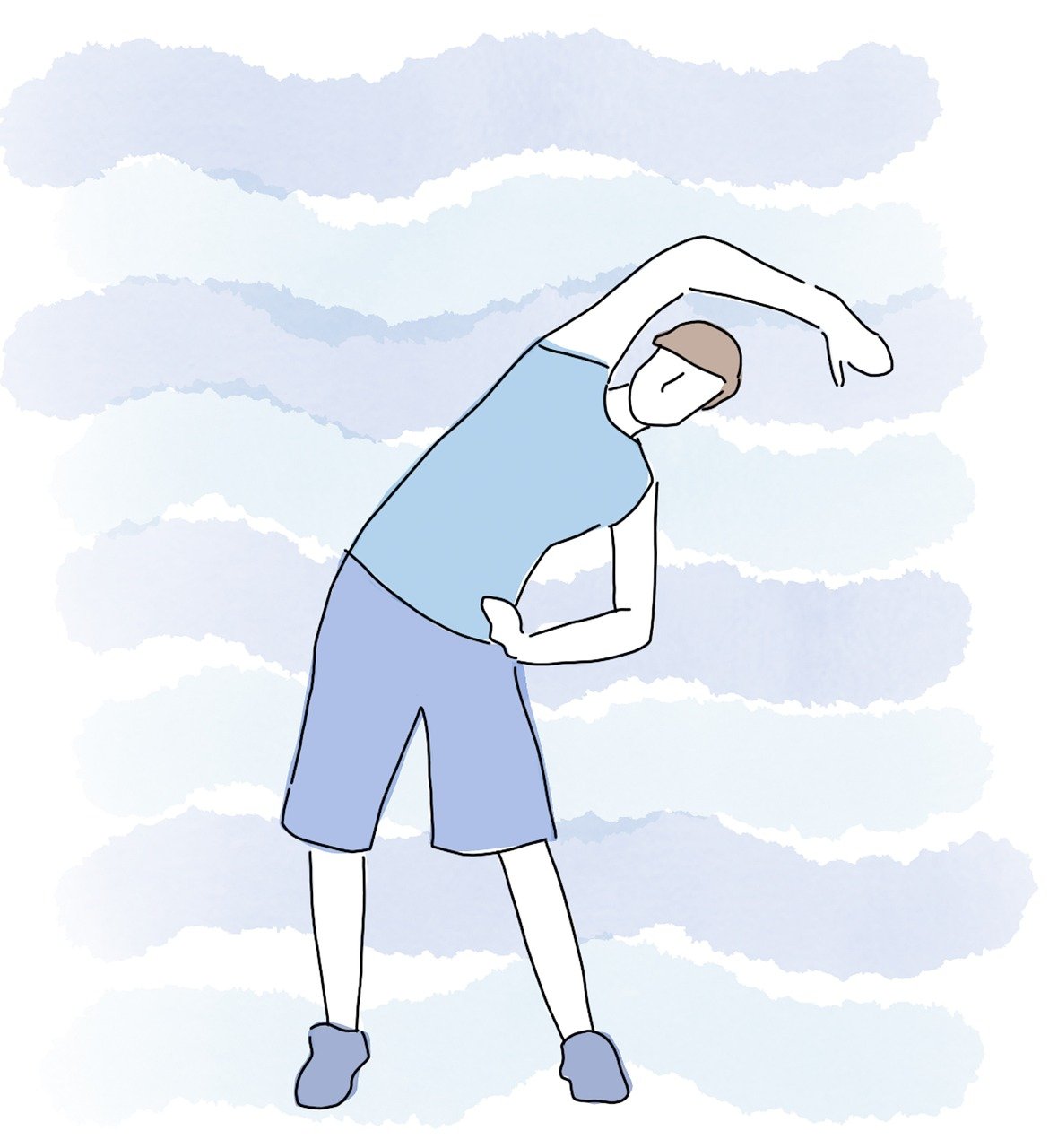
CrossFit or HIIT Classes
Joining a CrossFit gym
Joining a CrossFit gym offers a structured and supportive environment for high-intensity functional training. CrossFit workouts incorporate various elements of strength training, cardiovascular fitness, and functional movements. They are designed to challenge your body and push your limits, and can be modified to suit different fitness levels. CrossFit gyms provide knowledgeable coaches, a motivating community, and a wide range of equipment. Whether you’re a beginner or a seasoned athlete, joining a CrossFit gym can help you achieve your fitness goals, improve your overall strength and endurance, and become part of a supportive fitness community.
Attending HIIT classes
HIIT classes are high-intensity interval training sessions that deliver maximum results in a short amount of time. These classes incorporate bursts of intense exercise followed by short recovery periods, challenging your cardiovascular system and boosting your metabolism. HIIT classes can include various exercises like bodyweight movements, weightlifting, or cardio exercises, and are designed to strengthen your body and improve your overall fitness level. Attending HIIT classes provides structure, accountability, and a motivating atmosphere to push your limits and achieve your fitness goals.
Group fitness classes
Group fitness classes offer a fun and motivating way to stay fit and active. They provide a wide range of options, including dance-based classes, strength training classes, or yoga classes, to suit various preferences and fitness levels. Group fitness classes are led by certified instructors who guide you through exercises, provide modifications, and motivate you to achieve your best. The camaraderie and energy of a group setting can help you stay motivated and committed to your fitness routine. Whether you’re a beginner or an experienced exerciser, joining group fitness classes can help you stay accountable, improve your overall fitness, and make new friends along the way.
Boot camps
Boot camps are intensive training programs that combine different elements of cardiovascular fitness, strength training, and endurance exercises. These programs are usually led by experienced trainers and can be done both indoors or outdoors. Boot camps focus on full-body workouts and incorporate various equipment, such as medicine balls, resistance bands, and kettlebells. They provide a challenging and dynamic experience that helps to improve your strength, stamina, and overall fitness level. Participating in boot camps can push you beyond your comfort zone, provide a supportive group environment, and help you achieve your fitness goals.
Circuit training
Circuit training involves moving from one exercise to another with minimal rest in between, targeting different muscle groups and providing a full-body workout. It combines cardiovascular fitness, strength training, and endurance exercises into a challenging and efficient workout session. Circuit training can be done with various equipment or bodyweight exercises and can be modified to suit different fitness levels. It’s a versatile form of training that helps to improve your overall fitness, burn calories, and build both strength and endurance. Incorporating circuit training into your fitness routine can provide a dynamic and time-efficient workout that keeps you engaged and motivated.
Team Sports
Basketball
Basketball is a fast-paced team sport that provides a great cardiovascular workout while improving your agility, coordination, and overall athleticism. It involves running, jumping, and quick directional changes, engaging multiple muscle groups and challenging your cardiovascular endurance. Basketball is a great way to improve your teamwork skills, boost your mental focus, and enhance your hand-eye coordination. Whether you join a local league or shoot hoops with friends at the park, playing basketball offers a fun and challenging way to stay fit and active.
Soccer
Soccer, also known as football in many countries, is a popular team sport that offers a combination of cardiovascular fitness, skill development, and strategic thinking. It involves running, kicking, and passing the ball, engaging your legs, core, and cardiovascular system. Soccer helps to improve your stamina, lower body strength, and coordination. It also provides an opportunity to develop teamwork, communication, and decision-making skills. Whether you play competitively or casually with friends, soccer is a dynamic and enjoyable sport that helps you stay active while honing your athletic abilities.
Volleyball
Volleyball is a fast-paced team sport that combines elements of cardiovascular fitness, strength, and agility. It involves jumping, striking, and passing the ball, engaging your legs, shoulders, and core muscles. Volleyball helps to improve your reflexes, coordination, and cardiovascular endurance. It’s a great way to enhance your teamwork, communication, and decision-making skills while having fun with friends or participating in organized leagues. Whether you play on the beach or in an indoor court, volleyball provides a thrilling and physically demanding workout that pushes you to your limits.
Tennis
Tennis is an excellent sport that provides a full-body workout while enhancing your agility, hand-eye coordination, and mental focus. It involves running, striking the ball, and making quick decisions, engaging multiple muscle groups and challenging your cardiovascular fitness. Tennis helps to improve your strength, speed, and overall endurance. It can be played in singles or doubles, making it suitable for both individual competition and social interaction. Grab a racket, hit the court, and enjoy the physical and mental benefits of playing tennis.
Ultimate Frisbee
Ultimate Frisbee, also known as Ultimate, is a fast-paced team sport that combines elements of football, soccer, and flying disc games. It involves running, catching, and throwing a flying disc, engaging multiple muscle groups and challenging your cardiovascular fitness. Ultimate Frisbee helps to improve your agility, hand-eye coordination, and overall endurance. It’s a non-contact sport that promotes fair play, teamwork, and inclusivity. Whether you join a league or play informally with friends, Ultimate Frisbee offers a fun and active way to stay fit and enjoy the outdoors.
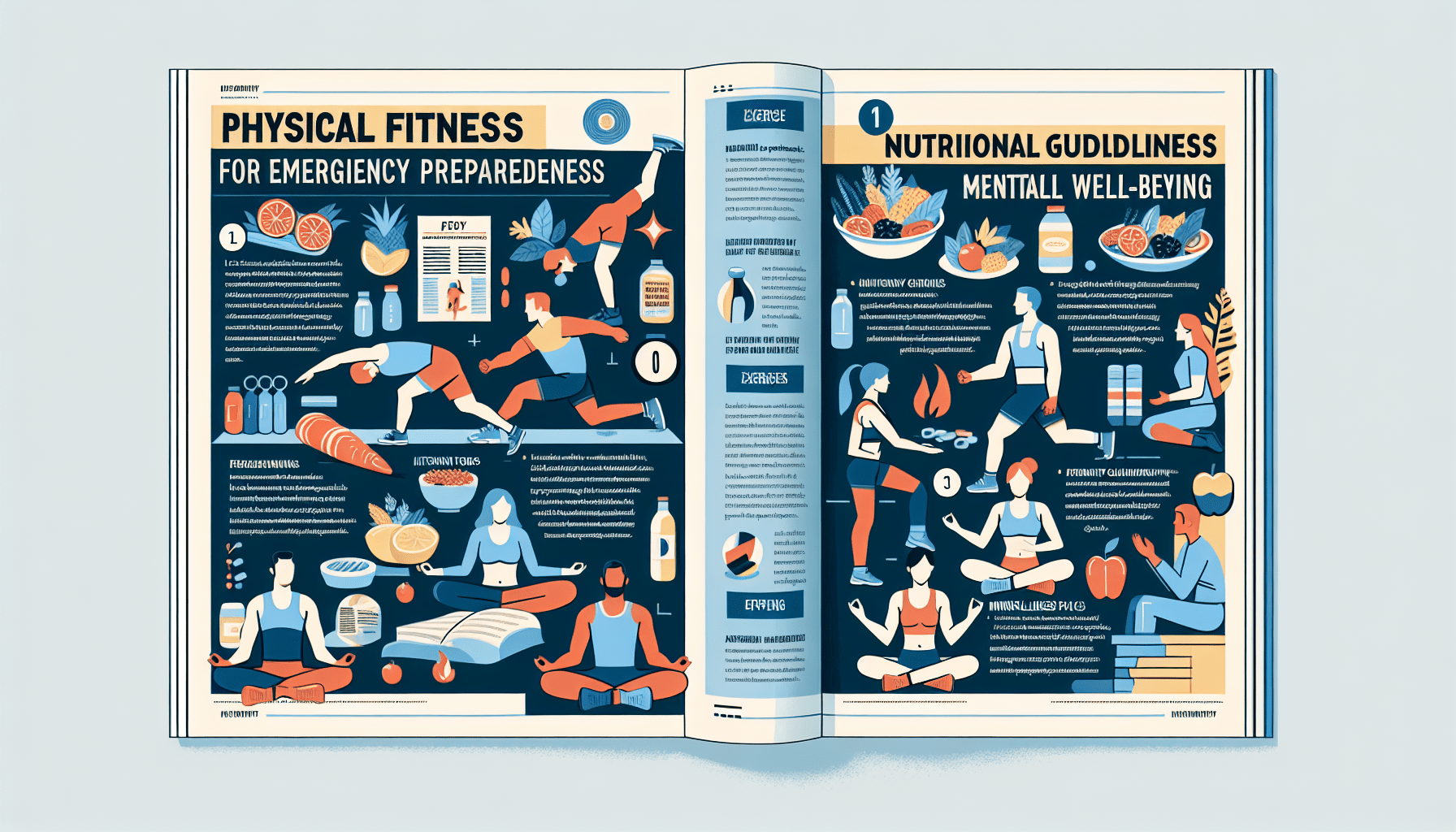
Combining Activities
Cycling and swimming
Combining cycling and swimming provides a well-rounded cardiovascular workout that challenges different muscle groups. Cycling helps to strengthen your leg muscles, improve your cardiovascular endurance, and burn calories. Swimming, on the other hand, engages your upper body muscles, improves your lung capacity, and provides a low-impact cardiovascular workout. Alternating between cycling and swimming not only adds variety to your fitness routine but also allows you to target different muscle groups while minimizing the impact on your joints. So hop on your bike and take a refreshing dip in the pool to enjoy the benefits of this dynamic exercise combination.
Running and strength training
Combining running and strength training provides a well-rounded workout that improves your cardiovascular fitness while building strength and endurance. Running helps to improve your cardiovascular endurance, burn calories, and promote fat loss. Strength training, on the other hand, helps to build muscle mass, increase your metabolism, and enhance your overall strength and stability. Incorporating bodyweight exercises or weightlifting into your running routine helps to strengthen your muscles, improve your running form, and prevent injuries. Whether you prefer to run outdoors or on a treadmill, incorporating strength training exercises can enhance your running performance and overall fitness.
Yoga and hiking
Combining yoga and hiking offers a harmonious blend of physical activity, mindfulness, and connection with nature. Yoga helps to improve your flexibility, strength, and mental clarity, enhancing your overall well-being. Hiking, on the other hand, provides a cardiovascular workout, strengthens your lower body, and allows you to immerse yourself in the beauty of the outdoors. Incorporating yoga sessions before or after hiking helps to stretch your muscles, improve your balance, and promote relaxation. Whether you practice yoga poses on mountaintops or meditate in peaceful hiking spots, combining yoga and hiking is a rejuvenating and holistic way to improve both your physical and mental fitness.
Pilates and rock climbing
Combining Pilates and rock climbing provides a comprehensive workout that focuses on core strength, stability, and flexibility. Pilates helps to strengthen your core muscles, improve your posture, and enhance your overall body control. Rock climbing engages your upper and lower body muscles, challenges your grip strength, and improves your overall coordination. Incorporating Pilates exercises into your rock climbing routine helps to improve your body awareness, stability, and core strength, enhancing your climbing performance and reducing the risk of injury. So strengthen your core with Pilates and conquer new heights with rock climbing to enjoy a purposeful and exciting exercise combination.
HIIT and functional fitness
Combining HIIT and functional fitness exercises provides a dynamic and effective workout that improves your overall strength, endurance, and functionality. HIIT workouts involve short bursts of intense exercises followed by short recovery periods, challenging your cardiovascular fitness and boosting your metabolism. Functional fitness exercises mimic everyday movements and improve your ability to perform daily activities with ease. Incorporating exercises such as bodyweight movements, kettlebell swings, or agility drills into your HIIT routine helps to improve your stability, coordination, and overall functional fitness. The combination of HIIT and functional fitness offers a time-efficient and challenging workout that pushes your limits and helps you achieve maximum results.
Consistency and Goal Setting
Creating a workout schedule
Creating a workout schedule is essential for maintaining consistency and achieving your fitness goals. Determine how many days a week you can realistically commit to exercise and identify the best times for your workouts. Consider your other commitments, work schedule, and personal preferences when creating your schedule. Write down your workout plan, including the type of exercise, duration, and intensity. Having a structured schedule helps you stay accountable, eliminates guesswork, and ensures that you allocate dedicated time for physical activity. Treat your workouts as important appointments and make them a priority in your daily routine.
Setting achievable fitness goals
Setting achievable fitness goals is crucial for maintaining motivation and tracking your progress. Start by defining specific and realistic goals that align with your interests and fitness level. Whether you want to run a certain distance, increase your strength, or improve your flexibility, make sure your goals are measurable and time-bound. Break down your larger goals into smaller milestones to keep yourself motivated and celebrate your achievements along the way. Remember to set both short-term and long-term goals to provide a sense of direction and purpose to your fitness journey.
Tracking progress
Tracking your progress is a powerful tool for staying motivated and measuring your success. Keep a record of your workouts, noting the type of exercise, duration, intensity, and any other relevant details. Use a fitness app, a journal, or a simple spreadsheet to track your progress over time. Regularly review your records to identify patterns, assess improvements, and identify areas for further growth. Monitoring your progress not only helps you stay accountable but also allows you to make adjustments to your workout routine based on your goals and achievements.
Staying motivated
Staying motivated is key to maintaining a consistent fitness routine. Find activities that you enjoy and that align with your interests and goals. Vary your workouts to keep them exciting and prevent boredom. Set rewards for reaching milestones or completing challenging workouts to keep yourself motivated. Surround yourself with a supportive community by joining fitness groups, attending classes, or finding a workout buddy. Remind yourself of the benefits of exercise, such as improved energy levels, stress reduction, and overall well-being. Experiment with different strategies and find what works best for you to stay motivated and committed to your fitness journey.
Rewarding yourself for milestones
Rewarding yourself for reaching milestones is a fun and motivating way to acknowledge your progress and stay committed to your fitness goals. Set small milestones along the way to your main objective and decide on rewards that resonate with you. Treat yourself to something you enjoy, such as a massage, a new workout outfit, or a delicious meal. Rewards help to create positive associations with your fitness journey and provide tangible, immediate gratification. Celebrating your achievements and enjoying the journey will keep you motivated, inspired, and excited to continue progressing towards your goals.
